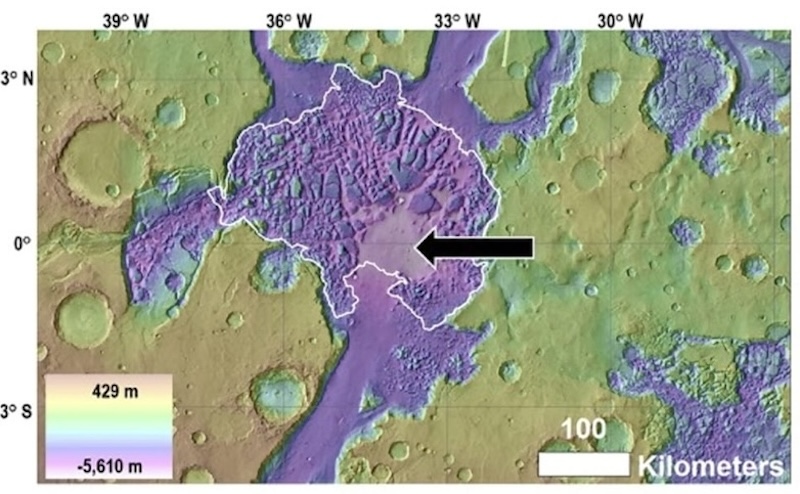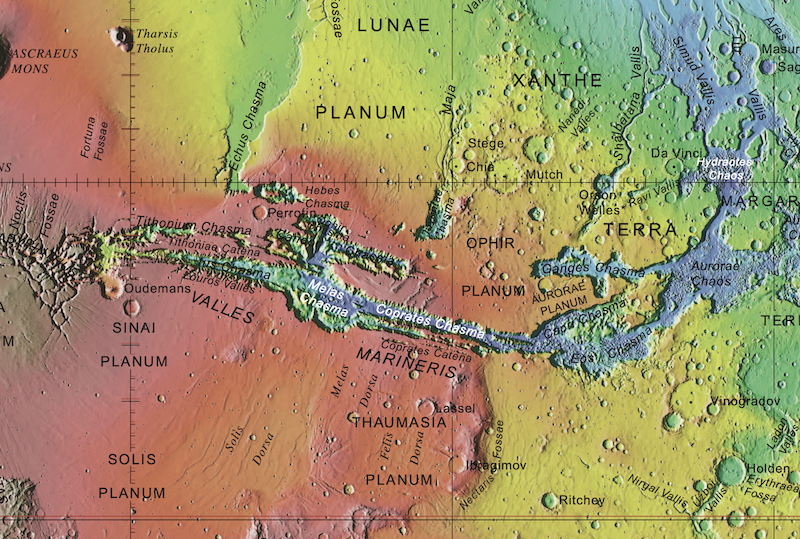Simulated flyover view of Mars. This is a region of chaotic terrain called Hydraotes Chaos. Researchers found an ancient mud lake in this region, which you can see beginning around minute 2:35. Could this mud lake on Mars hold traces of ancient microbial life? The data for the simulation is from ESA’s Mars Express orbiter. Video via ESA/ DLR/ FU Berlin.
On Earth, water means life. So ancient lakes on Mars would be good places to look for Martian life. On October 18, 2023, researchers at the Planetary Science Institute in Tucson, Arizona, announced they’ve found evidence for an ancient mud lake on Mars. They said it’s an ideal place for preserving microscopic biosignatures on Mars – evidence of past or present life – if such life ever existed.
They said a mud lake is a lake with accumulating muddy sediments on the bottom. You can see the mud lake on Mars in the video above, starting around 2:35. It’s near Mars’ northern lowlands, in a region of complex terrain, thought to have formed from ancient flood channels and aquifers.
The researchers – led by Alexis Rodriguez at the Planetary Science Institute – published their peer reviewed paper in Scientific Reports (Nature) on October 18.
The 2024 lunar calendars are here! Best Christmas gifts in the universe! Check ’em out here.
An ancient mud lake on Mars in Hydraotes Chaos
The mud lake is in a region called Hydraotes Chaos, which is just above the equator near the east end of the massive canyon Valles Marineris. This area is what scientists call chaotic terrain or chaos terrain, where aquifers once existed below the surface. In fact, the mud lake’s source of water was the aquifers in this area. The drier surface collapsed above the aquifers in this region, creating the jumbled “chaotic” terrain we see today.
Drainage – the natural removal of excess water – from the aquifers also formed the sedimentary plains within Hydraotes Chaos. Those sediments, once rich in water, could have preserved traces of ancient Martian microorganisms, just as they do on Earth. That subsurface environment could also have persisted long after all the water dried up on the surface and became inhospitable.
Rodriguez said:
Our research focuses on a sedimentary unit within Hydraotes Chaos, which we interpret to be the remnants of a mud lake formed by discharges from gas-charged mudstone stratigraphy dating back to nearly 4 billion years ago, a time when the surface of Mars was likely habitable. These sediments might harbor evidence of life from that or subsequent periods. It is important to remember that the subsurface of Mars might have included habitability lasting the duration of life’s history on Earth.
A complex landscape
In addition, ancient flood channels, thousands of miles long, cut across the Martian surface and end in the northern lowlands. Scientists have long postulated that a former ocean once filled these lowlands. The channels caused extensive erosion and released subsurface sediments from the aquifers. That material now covers much of the northern lowlands. This complexity of the landscape can make it difficult to study the ancient aquifers. As Rodriguez explained:
Venturing into the northern plains for sampling could prove precarious, as distinguishing between materials sourced from the aquifers and those eroded and transported during channel formation could become an intricate task. The plains, situated within Hydraotes Chaos, offer a unique glimpse into ancient aquifer materials. These plains, which we think formed from mud extruding into a basin directly above their source aquifer, provide a more targeted exploration opportunity. Unlike vast flood channels with their complex erosion patterns, this finding simplifies the examination of Martian aquifers, reducing the risk of overland sedimentary acquisition, and opens a new window into Mars’ geological past.
There are also mud volcanoes in this region. Those small volcanoes once released wet sediments containing salts to the surface, instead of hot magma.
Huge water-filled caverns
In addition to the aquifers – which are water-rich porous rock – there were also huge water-filled chambers in this chaotic terrain. Co-author Bryan Travis at the Planetary Science Institute said:
Our numerical models reveal a fascinating story. The lake’s source aquifer likely originated from phase segregation within the mudstone, forming vast water-filled chambers, several kilometers wide and hundreds of meters deep. This process was likely triggered by intrusive igneous activity. Moreover, the observed segmented subsidence across the chaotic terrain suggests an interconnected network of chambers, depicting stable water-filled giant caverns, some reaching kilometers in widths and lengths, way larger than any known Earth counterparts.


Mud lake on Mars could preserve ancient biomolecules
The resulting mud lake would have been an ideal place to preserve any biomolecules (biological molecules) associated with life. Rodriguez said:
Initially, biomolecules could have been dispersed throughout the volume of large groundwater-filled cavities. As the water was released to the surface and ponded, the water went away, leaving behind lags of sediments and potentially high concentrations of biomolecules.
As the paper said:
The meltwater, originating from varying thermally affected mudstone depths, could have potentially harbored diverse biosignatures, which could have become concentrated within the lake’s sedimentary residue.
A mission to Hydraotes Chaos?
The sediments left behind on the surface, from the original aquifers, are still there today. They would be a good target for sampling in a future Mars mission. And in fact, NASA is considering doing just that, as co-author Mary Beth Wilhelm, at NASA Ames Research Center, noted:
NASA Ames is considering the plains as a possible landing site for a mission to search for evidence of biomarkers, specifically lipids. These biomolecules are extremely resistant and could have endured billions of years on Mars.
The paper added:
Thus, we propose that Hydraotes Chaos merits priority consideration in future missions aiming to detect Martian biosignatures.
Co-author Jeffrey Kargel at the Planetary Science Institute added:
In addition, the study region includes widespread mud volcanoes and possible diapirs, providing additional windows into subsurface, potentially habitable rocks. A small rover could, within short distances, sample the mud lake sediments and these materials, dramatically increasing the odds of biosignature detection.
Bottom line: Researchers at the Planetary Science Institute said that an ancient mud lake on Mars would be an ideal place to search for evidence of ancient microbial life.
Via Planetary Science Institute
The post Ancient mud lake on Mars could hold traces of life first appeared on EarthSky.
0 Commentaires